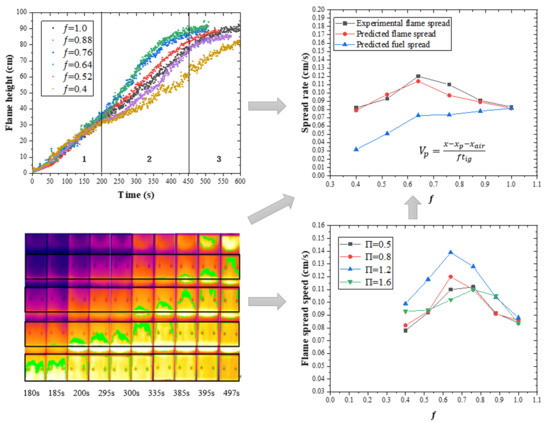Thermodynamic and Kinetic Characteristics of Combustion of Discrete Polymethyl Methacrylate Plates with Different Spacings in Concave Building Facades
Abstract
1. Introduction
2. Experimental Device, Materials and Methods
2.1. Experimental Device
2.2. Experimental Materials
2.3. Experimental Methods
3. Results and Discussion
3.1. Flame Shape
3.2. Flame Height
3.3. Pyrolysis Front Propagation
3.4. Theoretical Model of Flame Spread Rate
3.5. Experimental Flame Spread Rate and Comparison with Prediction
4. Conclusions
- (1)
- The flame shapes and flame height are significantly different under different concave structure factor and fuel coverage. The flame height could be divided into three stages: initial flame spread stage, flame spread development stage, stable flame spread stage. In the flame spread development stage, when the structure factor is fixed, the average flame height increases first and then decreases with the increase of fuel coverage, and reaches the maximum value when the fuel coverage is between 0.64 and 0.76.
- (2)
- Three different patterns of pyrolysis front propagation are observed for different fuel coverages due to the existence of air gaps. When the structure factor is fixed, the flame spread rate first increases and then decreases with an increase in fuel coverage, and reaches the maximum value when the fuel coverage is between 0.64 and 0.76. When the fuel coverage is fixed, the flame spread rate first increases and then decreases with increasing structure factor, and reaches the maximum value when the structure factor is 1.2.
- (3)
- A model for predicting the flame spread rate of discrete polymethyl methacrylate plates is established based on the model suitable for continuous flame spread. The predicted flame spread rate is consistent with the experimental results. It is found that the fuel spread rate of discrete polymethyl methacrylate plates rises with the increase of fuel coverage.
Author Contributions
Funding
Institutional Review Board Statement
Informed Consent Statement
Data Availability Statement
Acknowledgments
Conflicts of Interest
Nomenclature
| flame spread rate [cm/s] | |
| vertical length of pyrolysis zone [cm] | |
| П | structure factor (the ratio of the side wall width to back wall width) |
| flame height (cm) | |
| effective preheating zone length (preheating zone length subtracting vertical length of air gaps) (cm) | |
| flame spread rate (advancement rate of total pyrolysis zone) (cm/s) | |
| fuel spread rate (advancement rate of fuel pyrolysis zone) (cm/s) | |
| total length of air gaps in preheating zone (cm) | |
| ƒ | fuel coverage |
| preheating zone length (cm) | |
| ignition time (s) | |
| k | thermal conductivity ) |
| ρ | density ) |
| specific heat ) | |
| pyrolysis temperature ) | |
| σ | Stefan-Boltzmann constant ) |
| flame temperature ) | |
| dimensionless heat release rate | |
| Lc | characteristic length ) |
| convective heat flux ) | |
| radiative heat flux ) | |
| Abbreviations | |
| PMMA | polymethyl methacrylate |
References
- Ueda, K.; Tanaka, K.; Chujo, Y. Fluoroalkyl POSS with dual functional groups as a molecular filler for lowering refractive indices and improving thermomechanical properties of PMMA. Polymers 2018, 10, 1332. [Google Scholar] [CrossRef] [PubMed]
- Wang, C.; Dai, Y.; Kou, B.; Huang, W. Influence of long-term storage on shape memory performance and mechanical behavior of pre-stretched commercial poly(methyl methacrylate) (PMMA). Polymers 2019, 11, 1978. [Google Scholar] [CrossRef] [PubMed]
- Gutierrez, M.P.; Zohdi, T.I. Effective reflectivity and heat generation in sucrose and PMMA mixtures. Energy Build. 2014, 71, 95–103. [Google Scholar] [CrossRef]
- Zhu, H.; Zhu, G.; Gao, Y.; Zhao, G. Experimental studies on the effects of spacing on upward flame spread over thin PMMA. Fire Technol. 2017, 53, 673–693. [Google Scholar] [CrossRef]
- Zhu, H.; Gao, Y.; Pan, R.; Zhong, B. Spacing effects on downward flame spread over thin PMMA slabs. Case Stud. Therm. Eng. 2019, 13, 100370. [Google Scholar] [CrossRef]
- Miller, C.H.; Gollner, M.J. Upward flame spread over discrete fuels. Fire Saf. J. 2015, 77, 36–45. [Google Scholar] [CrossRef]
- Yan, W.; Shen, Y.; Jiang, L.; An, W.; Zhou, Y.; Li, Z.; Sun, J. Experimental study of sidewall and pressure effect on vertical downward flame spread over insulation material. Fire Sci. Technol. 2015, 823–830. [Google Scholar] [CrossRef]
- Fire Discussion: Kaifeng, Henan 314 Fire, from the 3rd Floor to the 17th Floor in Two Minutes! Available online: https://www.sohu.com/a/302558104_120034565 (accessed on 20 March 2019). (In Chinese).
- Cai, M.; Chen, S.; Tang, Y.; Li, Q.; An, W. Study on the influence of enclosed vertical channels on downward flame spread over XPS thermal insulation materials. Case Stud. Therm. Eng. 2019, 14, 100486. [Google Scholar] [CrossRef]
- Matsuoka, T.; Nakashima, K.; Yamazaki, T.; Nakamura, Y. Geometrical effects of a narrow channel on flame spread in an opposed flow. Combust. Sci. Technol. 2017, 190, 409–424. [Google Scholar] [CrossRef]
- Tao, S.; Fang, J.; Meng, Y.; Shah, H.R.; Yang, L. Ignition risk analysis of common building material cylindrical PMMA exposed to an external irradiation with in-depth absorption. Constr. Build. Mater. 2020, 251, 118955. [Google Scholar] [CrossRef]
- Zhou, B.; Yoshioka, H.; Noguchi, T.; Wang, K. Experimental study of time-averaged upward fire propagation speed of expanded polystyrene external thermal insulation composite systems masonery façade. Fire Mater. 2020. online version. [Google Scholar] [CrossRef]
- Peng, F.; Lai, D.; Zheng, Y.; Yang, L. Effects of ceiling inclination on lateral flame spread over vertical Poly(methyl meth-acrylate) surface. Case Stud. Therm. Eng. 2019, 15, 100519. [Google Scholar] [CrossRef]
- Gao, S.; Zhu, G.; Gao, Y.; Zhou, J. Experimental study on width effects on downward flame spread over thin PMMA under limited distance condition. Case Stud. Therm. Eng. 2019, 13, 100382. [Google Scholar] [CrossRef]
- Chu, T.; Zhu, G.; Chai, G.; Gao, Y. Study on upward flame spread of cotton fabrics with different moisture regain. Case Stud. Therm. Eng. 2020, 21, 100683. [Google Scholar] [CrossRef]
- Liang, Z.-H.; Zhu, G.-Q.; Liu, H.-N.; Zhou, X. Flame characteristic and ceiling temperature distribution under the effect of curved sidewall. Case Stud. Therm. Eng. 2019, 14, 100453. [Google Scholar] [CrossRef]
- Zeinali, D.; Verstockt, S.; Beji, T.; Maragkos, G.; DeGroote, J.; Merci, B. Experimental study of corner fires—Part I: Inert panel tests. Combust. Flame 2018, 189, 472–490. [Google Scholar] [CrossRef]
- Zeinali, D.; Verstockt, S.; Beji, T.; Maragkos, G.; DeGroote, J.; Merci, B. Experimental study of corner fires—Part II: Flame spread over MDF panels. Combust. Flame 2018, 189, 491–505. [Google Scholar] [CrossRef]
- Jiang, L.; Xiao, H.-H.; An, W.; Zhou, Y.; Sun, J. Correlation study between flammability and the width of organic thermal insulation materials for building exterior walls. Energy Build. 2014, 82, 243–249. [Google Scholar] [CrossRef]
- Ma, X.; Tu, R.; Cheng, X.; Zhu, S.; Ma, J.; Fang, T. Experimental study of thermal behavior of insulation material rigid polyu-rethane in parallel, symmetric, and adjacent building facade constructions. Polymers 2018, 10, 1104. [Google Scholar] [CrossRef]
- Tao, C.; Shen, Y.; Zong, R. Experimental study on virtual origins of buoyancy-controlled jet flames with sidewalls. Appl. Therm. Eng. 2016, 106, 1088–1093. [Google Scholar] [CrossRef]
- Gao, Z.; Ji, J.; Fan, C.; Sun, J.; Zhu, J. Influence of sidewall restriction on the maximum ceiling gas temperature of buoyancy-driven thermal flow. Energy Build. 2014, 84, 13–20. [Google Scholar] [CrossRef]
- Tsai, K.-C. Influence of sidewalls on width effects of upward flame spread. Fire Saf. J. 2011, 46, 294–304. [Google Scholar] [CrossRef]
- An, W.; Shen, Y.; Jiang, L.; Sun, J. Experimental study on fire risk of buildings’ U-shaped exterior wall on flame propagation of insulation material on plain and plateau. J. Fire Sci. 2015, 33, 358–373. [Google Scholar] [CrossRef]
- An, W.; Sun, J.; Liew, K.; Zhu, G. Effects of building concave structure on flame spread over extruded polystyrene thermal insulation material. Appl. Therm. Eng. 2017, 121, 802–809. [Google Scholar] [CrossRef]
- Park, J.; Brucker, J.; Seballos, R.; Kwon, B.; Liao, Y.-T.T. Concurrent flame spread over discrete thin fuels. Combust. Flame 2018, 191, 116–125. [Google Scholar] [CrossRef]
- Cui, W.; Liao, Y.-T.T. Experimental study of upward flame spread over discrete thin fuels. Fire Saf. J. 2019, 110, 102907. [Google Scholar] [CrossRef]
- Wang, Z.; Liang, W.; Cai, M.; Tang, Y.; Li, S.; An, W.; Zhu, G. Experimental study on flame spread over discrete extruded polystyrene foam with different fuel coverage rates. Case Stud. Therm. Eng. 2020, 17, 100577. [Google Scholar] [CrossRef]
- Hwang, C.C.; Xie, Y. Flame propagation along Matchstick Arrayson, inclined base boards. Combust. Sci. Technol. 1984, 42, 1–12. [Google Scholar] [CrossRef]
- Gollner, M.J.; Xie, Y.; Lee, M.; Nakamura, Y.; Rangwala, A.S. Burning behavior of vertical matchstick arrays. Combust. Sci. Technol. 2012, 184, 585–607. [Google Scholar] [CrossRef]
- Xiong, X.; Gao, K.; Zhang, J.; Li, B.; Xie, L.; Zhang, D.; Mensah, R.A. Interaction between shock wave and solid particles: Establishing a model for the change of cloud’s expansion rate. Powder Technol. 2020, in press. [Google Scholar] [CrossRef]
- Vogel, M.; Williams, F.A. Flame propagation along matchstick arrays. Combust. Sci. Technol. 1970, 1, 429–436. [Google Scholar] [CrossRef]
- Jiang, L.; Zhao, Z.; Tang, W.; Miller, C.; Sun, J.-H.; Gollner, M.J. Flame spread and burning rates through vertical arrays of wooden dowels. Proc. Combust. Inst. 2019, 37, 3767–3774. [Google Scholar] [CrossRef]
- Altarawneh, M.; Carrizo, D.; Ziolkowski, A.; Kennedy, E.M.; Dlugogorski, B.Z.; Mackie, J.C. Pyrolysis of permethrin and formation of precursors of polychlorinated dibenzo-p-dioxins and dibenzofurans (PCDD/F) under non-oxidative conditions. Chemosphere 2009, 74, 1435–1443. [Google Scholar] [CrossRef] [PubMed]
- Altarawneh, M.; Radny, M.W.; Smith, P.V.; Mackie, J.C.; Kennedy, E.M.; Dlugogorski, B.Z.; Soon, A.; Stampfl, C. A first-principles density functional study of chlorophenol adsorption on Cu2O (110): CuO. J. Chem. Phys. 2009, 130, 184505. [Google Scholar] [CrossRef]
- Chen, X.; Liu, J.; Zhou, Z.; Li, P.; Zhou, T.; Zhou, D.; Wang, J. Experimental and theoretical analysis on lateral flame spread over inclined PMMA surface. Int. J. Heat Mass Transf. 2015, 91, 68–76. [Google Scholar] [CrossRef]
- Tsai, K.-C. Width effect on upward flame spread. Fire Saf. J. 2009, 44, 962–967. [Google Scholar] [CrossRef]
- Jiang, L.; He, J.-J.; Sun, J. Sample width and thickness effects on upward flame spread over PMMA surface. J. Hazard. Mater. 2018, 342, 114–120. [Google Scholar] [CrossRef]
- An, W.; Wang, Z.; Xiao, H.-H.; Sun, J.; Liew, K. Thermal and fire risk analysis of typical insulation material in a high elevation area: Influence of sidewalls, dimension and pressure. Energy Convers. Manag. 2014, 88, 516–524. [Google Scholar] [CrossRef]
- Shi, L.; Chew, M.Y.L.; Novozhilov, V.; Joseph, P. Modeling the pyrolysis and combustion behaviors of non-charring and intu-mescent-protected polymers using “Fires Cone”. Polymers 2015, 7, 1979–1997. [Google Scholar] [CrossRef]
- Qiao, Y.; Das, O.; Zhao, S.-N.; Sun, T.-S.; Xu, Q.; Jiang, L. Pyrolysis kinetic study and reaction mechanism of epoxy glass fiber reinforced plastic by thermogravimetric analyzer (TG) and TG–FTIR (fourier-transform infrared) techniques. Polymers 2020, 12, 2739. [Google Scholar] [CrossRef]
- Tang, F. Studies on Facade Flame Behavior Ejected from Opening of a Building Compartment under Different External Boundary and Pressure Conditions. Ph.D. Thesis, University of Science and Technology of China, Hefei, China, 2013. [Google Scholar]
- Meng, Q.X.; Zhu, G.Q.; Yu, M.M.; Liang, Z.H. Experimental study on upward flame spread characteristics of external thermal insulation material under the influence of porosity. Case Stud. Therm. Eng. 2018, 12, 365–373. [Google Scholar] [CrossRef]
- Zhao, K. Studies on Three-Dimensional Downward Flame Spread over Uninhibited PMMA Slabs. Ph.D. Thesis, University of Science and Technology of China, Hefei, China, 2013. [Google Scholar]
- Xiao, J.; Das, O.; Mensah, R.A.; Jiang, L.; Xu, Q.; Berto, F. Ablation behavior studies of charring materials with different thickness and heat flux intensity. Case Stud. Therm. Eng. 2020, 100814. [Google Scholar] [CrossRef]
- Gollner, M.J.; Williams, F.; Rangwala, A. Upward flame spread over corrugated cardboard. Combust. Flame 2011, 158, 1404–1412. [Google Scholar] [CrossRef]
- Comas, B.; Carmona, A.; Pujol, T. Experimental study of the channel effect on the flame spread over thin solid fuels. Fire Saf. J. 2015, 71, 162–173. [Google Scholar] [CrossRef]
- Kashiwagi, T.; Omori, A.; Brown, J. Effects of material characteristics on flame spreading. Fire Saf. Sci. 1989, 2, 107–117. [Google Scholar] [CrossRef][Green Version]
- Quintiere, J.G. Fundamentals of Fire Phenomena; John Wiley & Sons, Ltd.: Hoboken, NJ, USA, 2006. [Google Scholar]
- An, W.; Yin, X.; Cai, M.; Gao, Y.; Wang, H. Influence of vertical channel on downward flame spread over extruded polystyrene foam. Int. J. Therm. Sci. 2019, 145, 105991. [Google Scholar] [CrossRef]
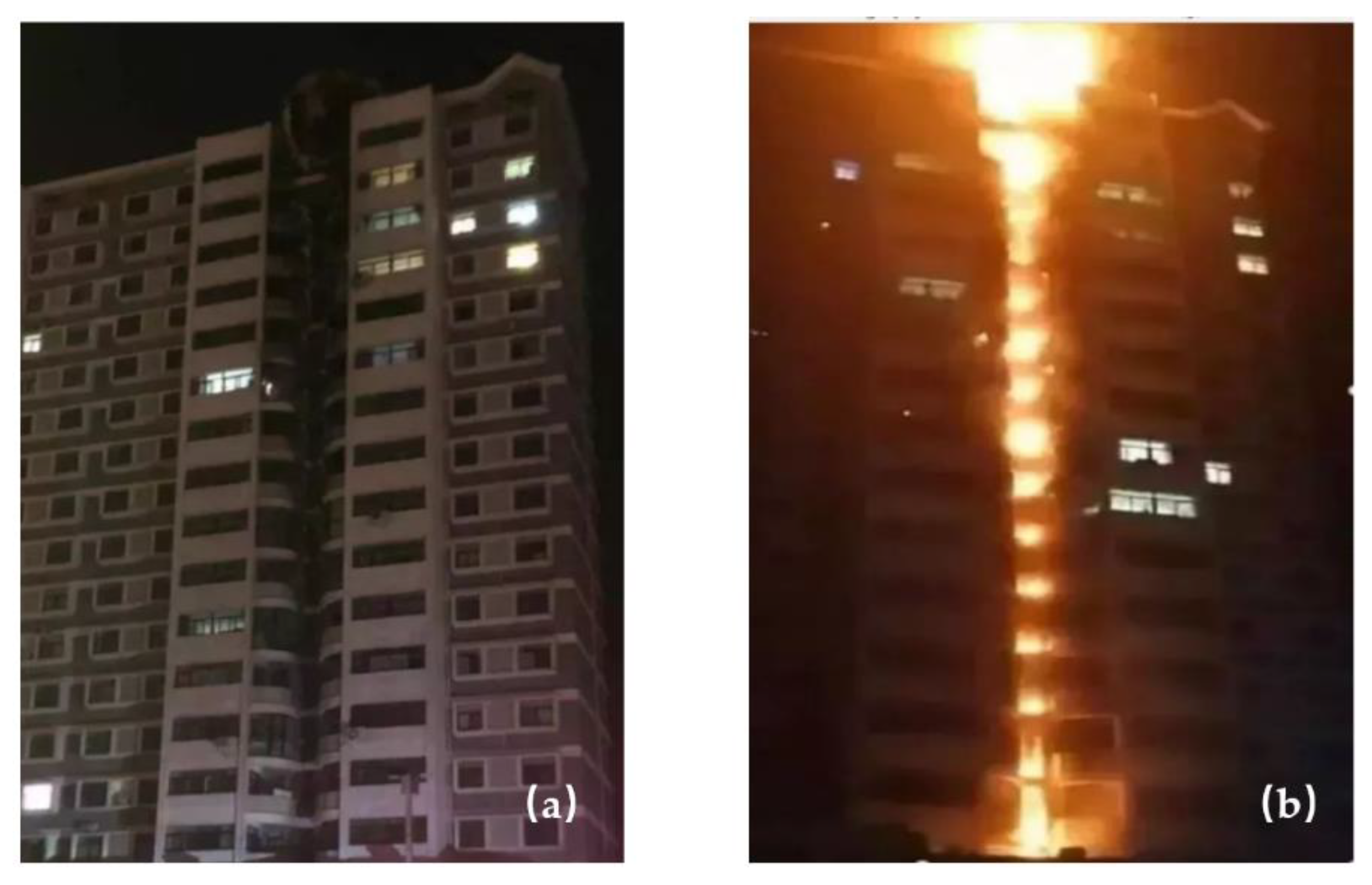
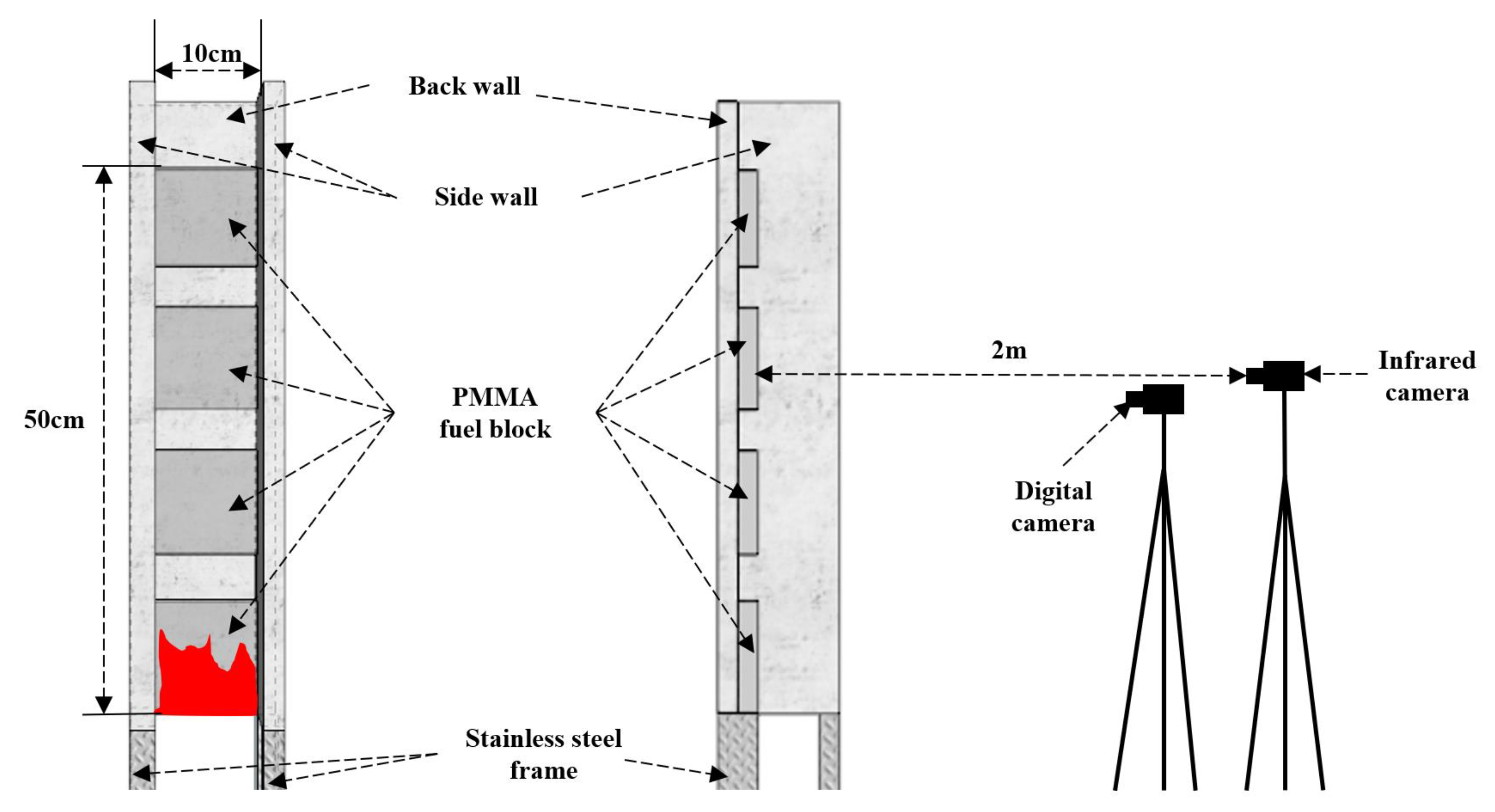
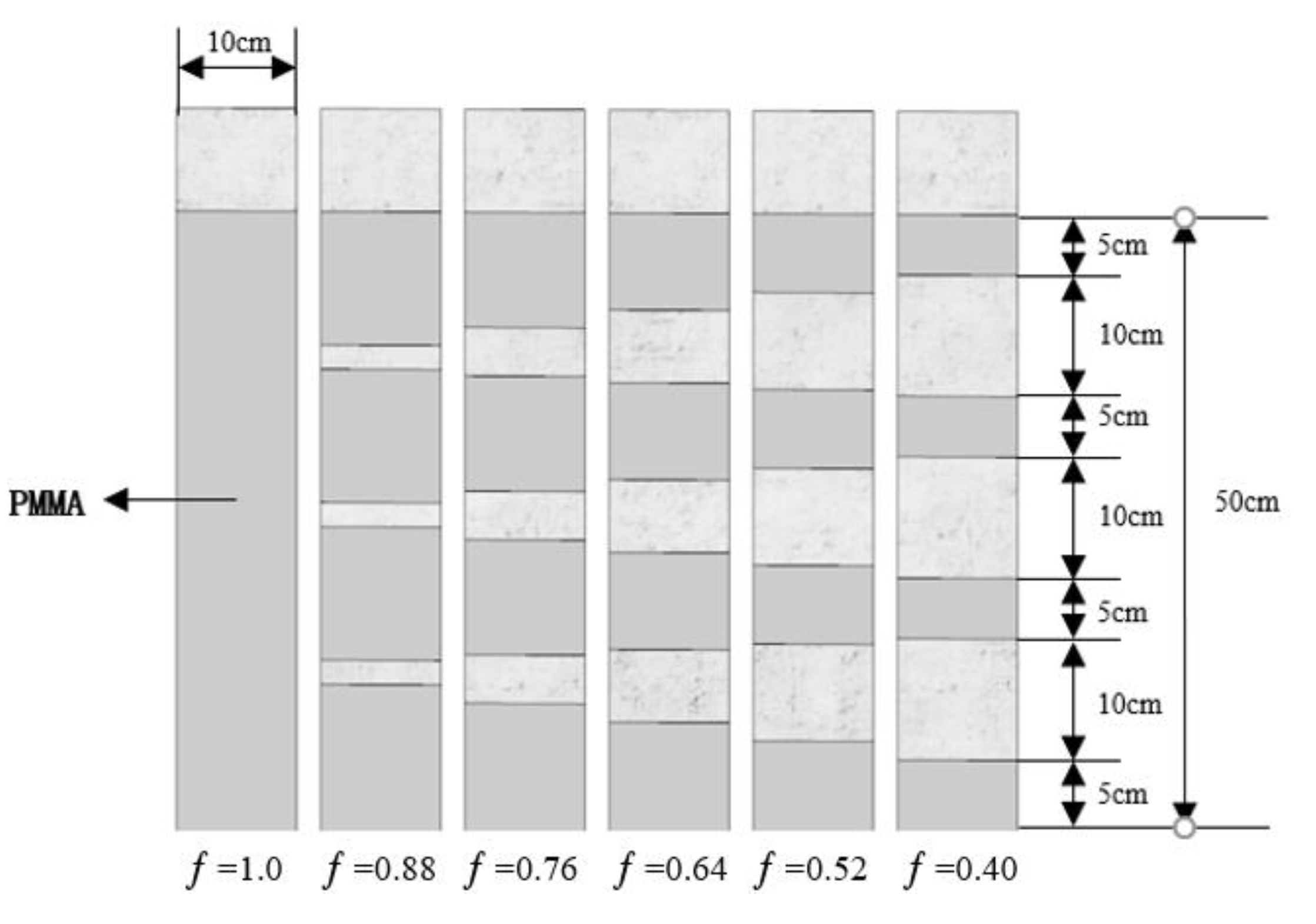
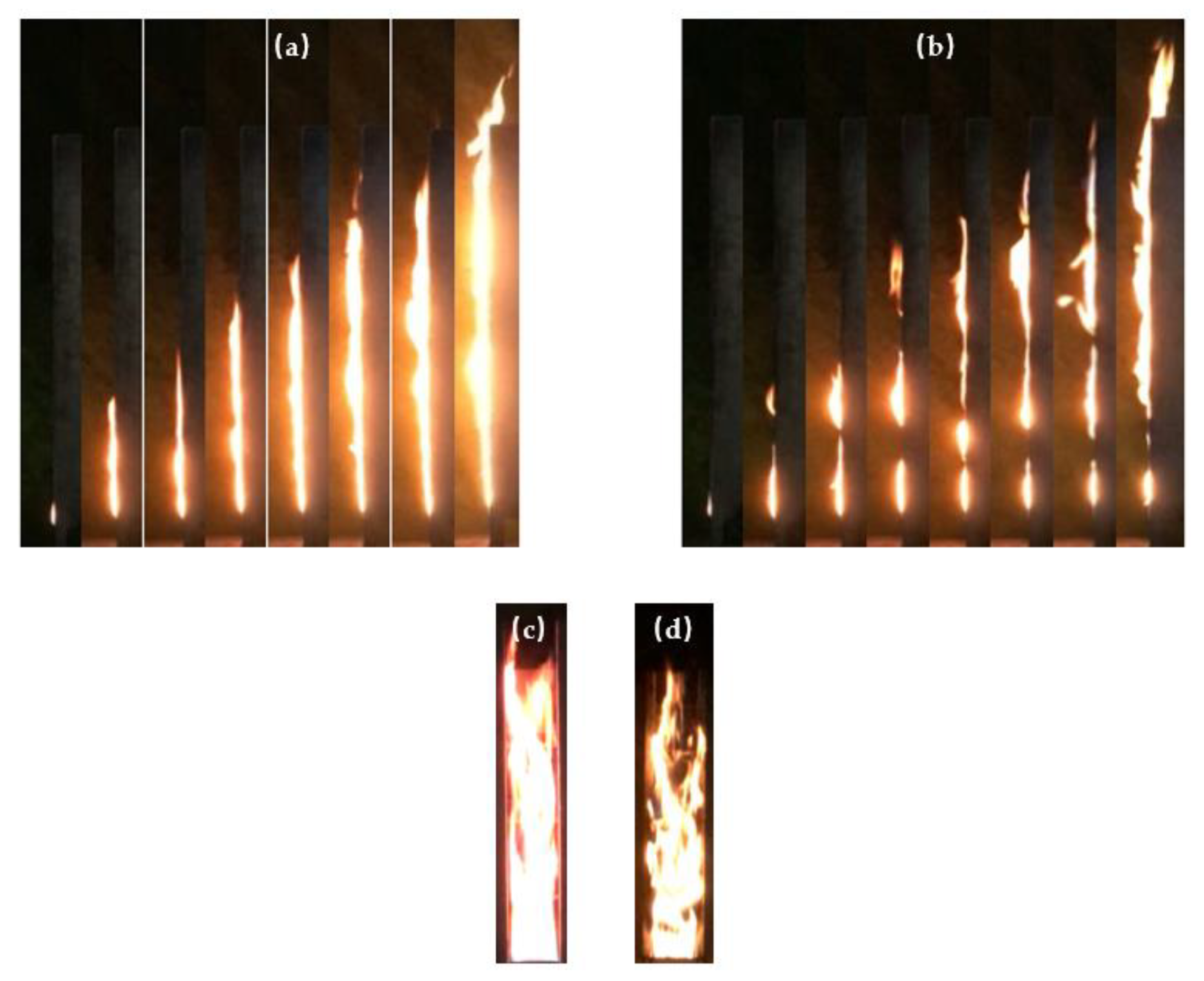
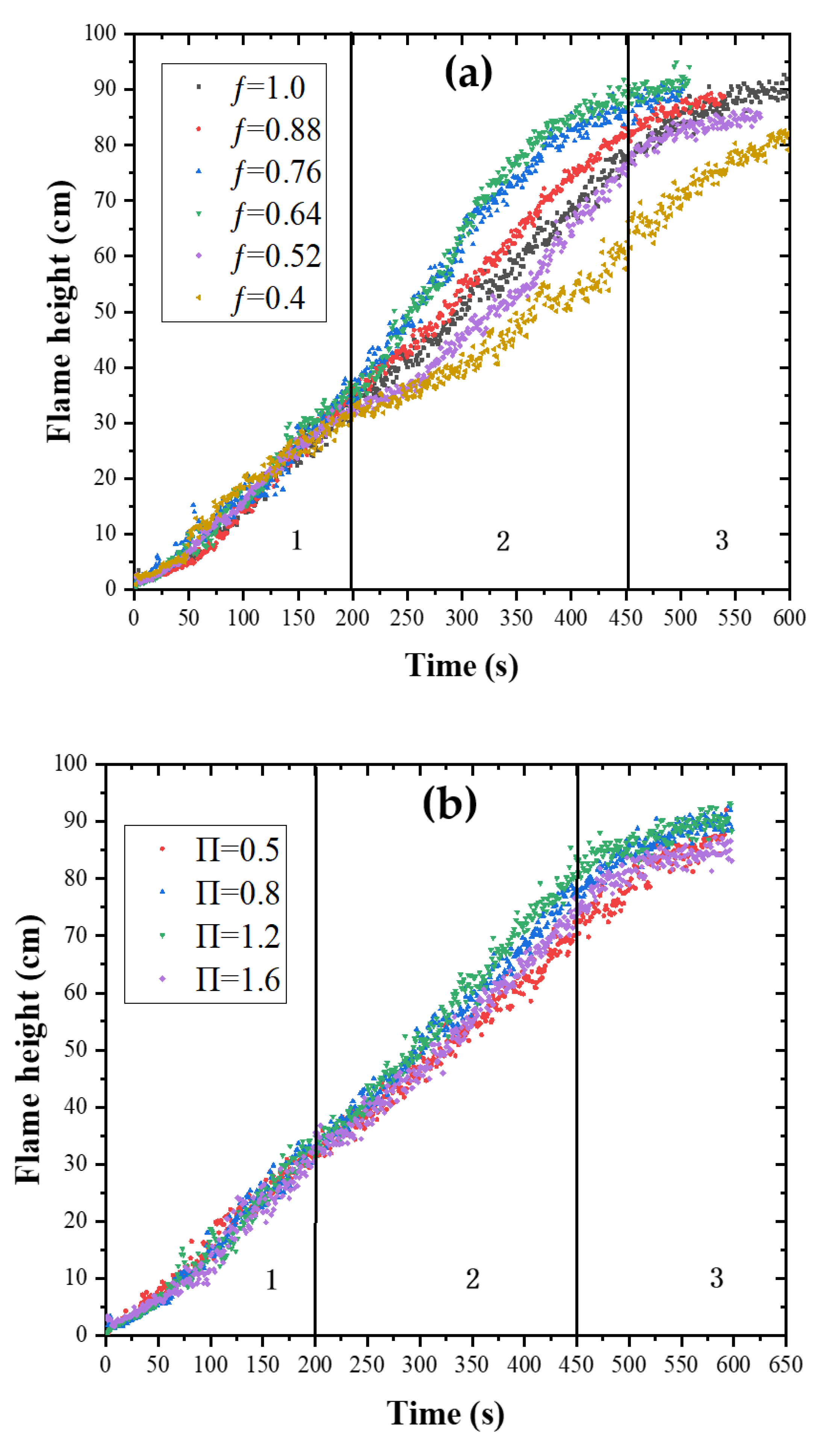
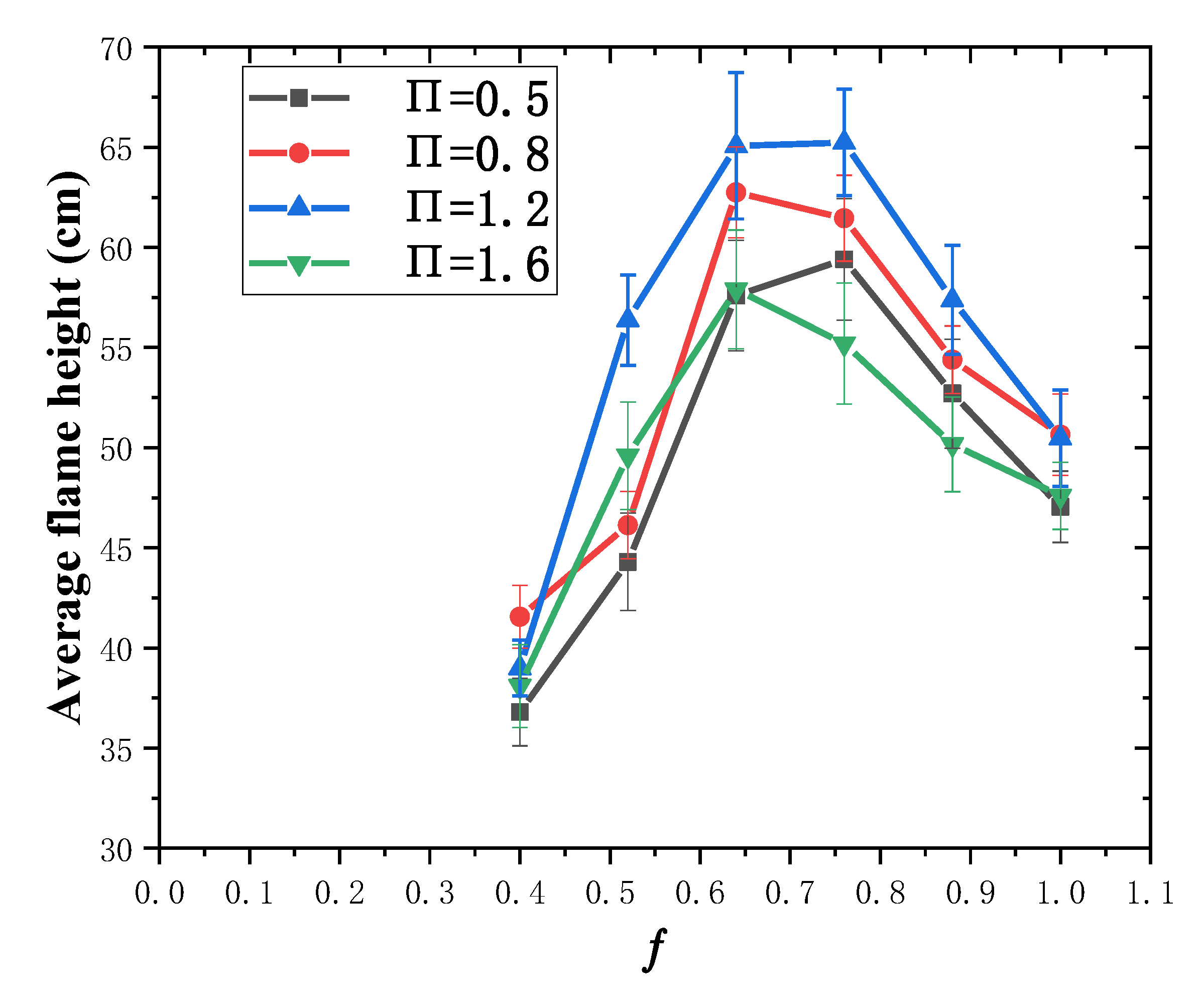

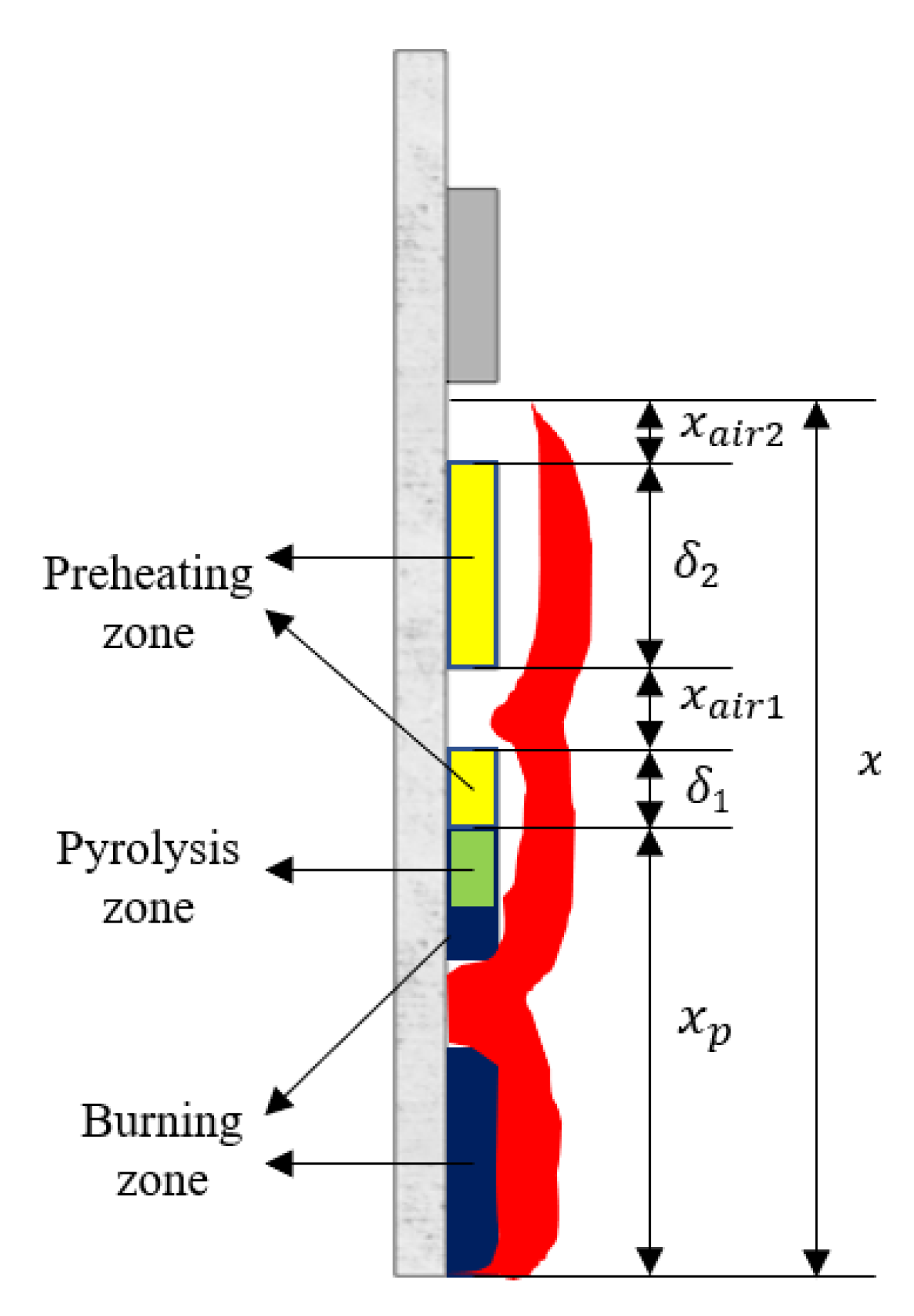
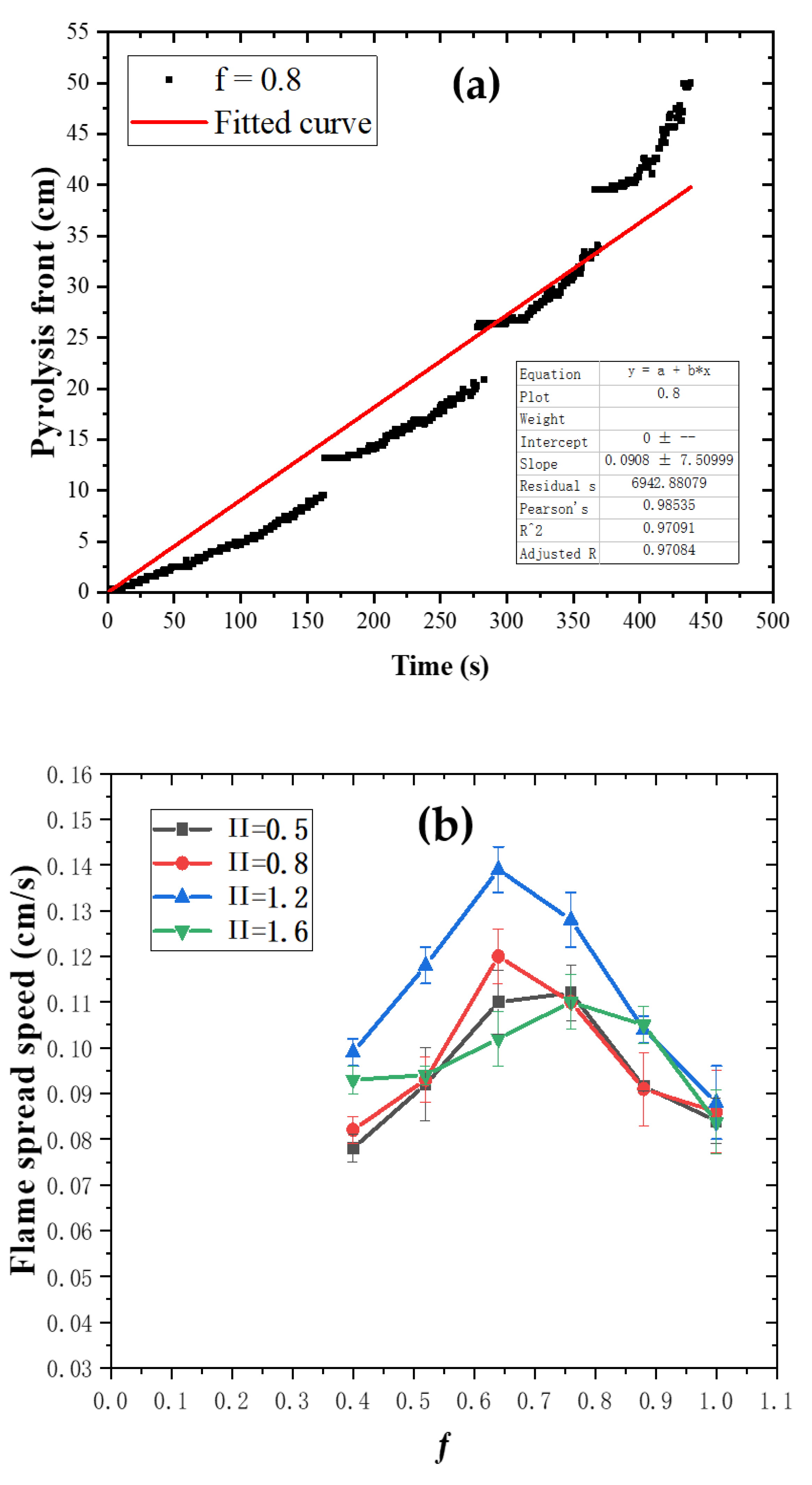
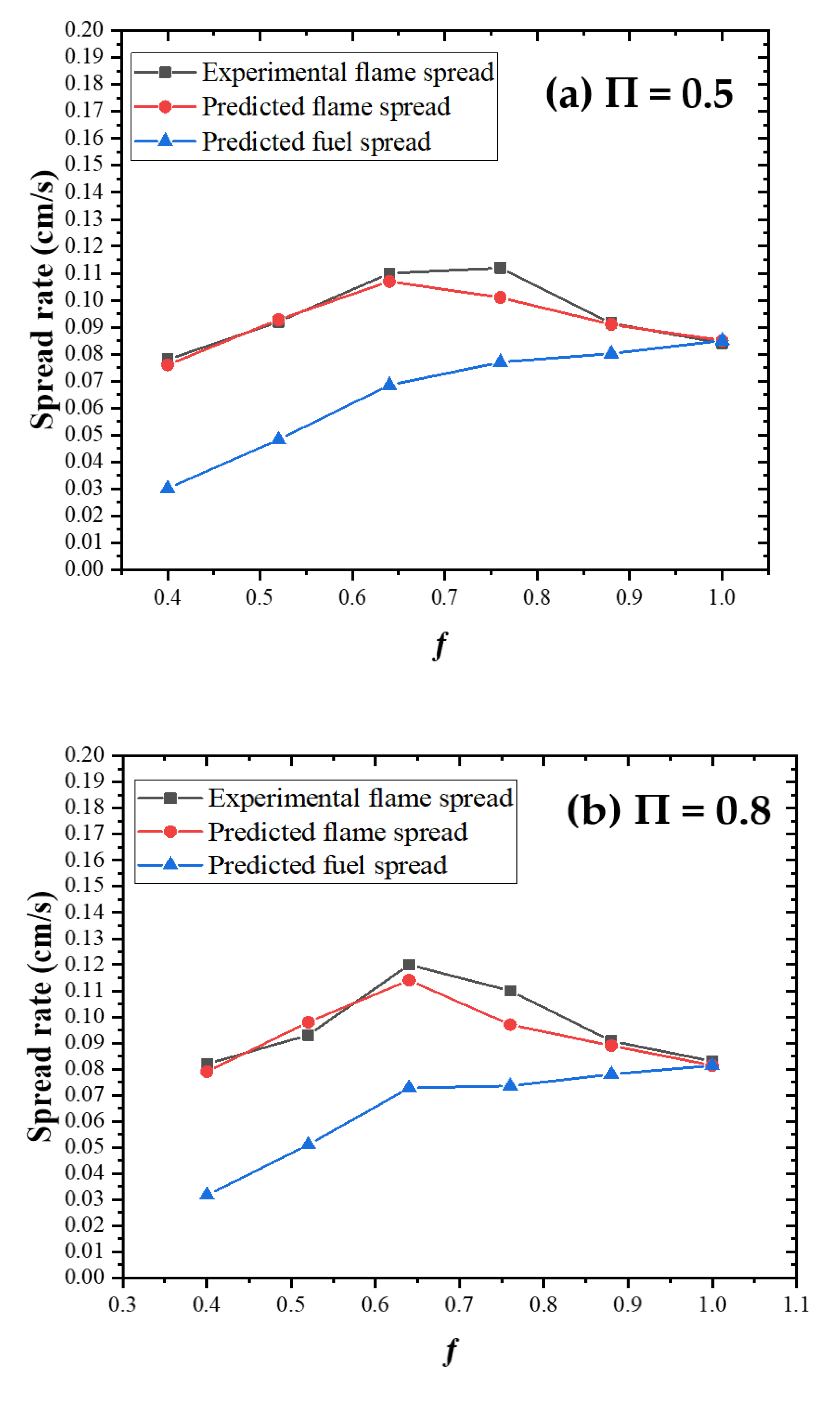
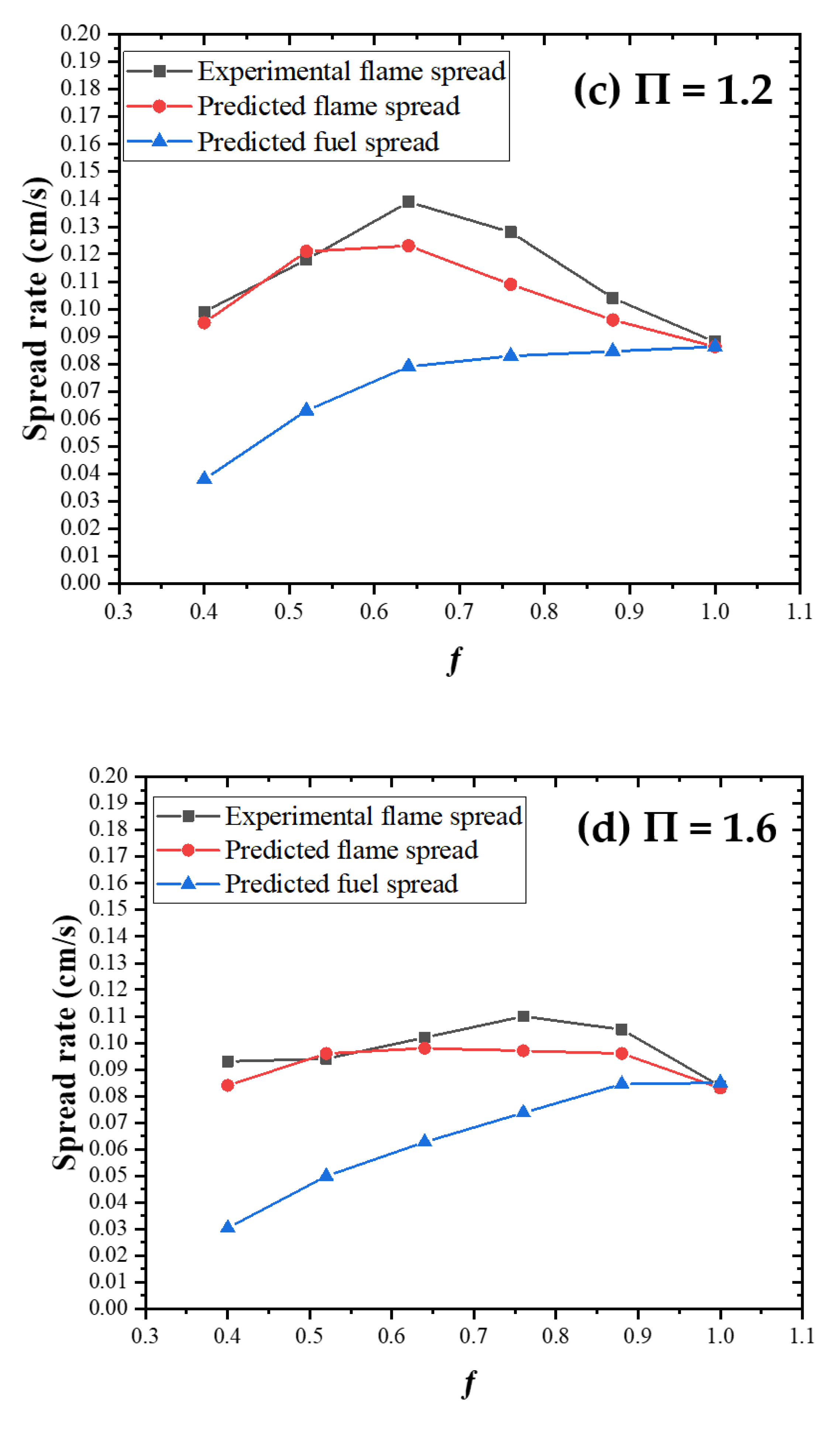
| Material | ||||||
|---|---|---|---|---|---|---|
| PMMA | 0.05 | 1190 | 1400 | 623 | 1073 | 5.67 × |
| Experimental Condition Number | 1# | 2# | 3# | 4# |
|---|---|---|---|---|
| Back wall width/cm | 10 | 10 | 10 | 10 |
| Side wall width/cm | 5 | 8 | 12 | 16 |
| Structure factor (П) | 0.5 | 0.8 | 1.2 | 1.6 |
Publisher’s Note: MDPI stays neutral with regard to jurisdictional claims in published maps and institutional affiliations. |
© 2021 by the authors. Licensee MDPI, Basel, Switzerland. This article is an open access article distributed under the terms and conditions of the Creative Commons Attribution (CC BY) license (http://creativecommons.org/licenses/by/4.0/).
Share and Cite
An, W.; Peng, L.; Cai, M.; Hu, K.; Li, S.; Wang, T. Thermodynamic and Kinetic Characteristics of Combustion of Discrete Polymethyl Methacrylate Plates with Different Spacings in Concave Building Facades. Polymers 2021, 13, 167. https://doi.org/10.3390/polym13010167
An W, Peng L, Cai M, Hu K, Li S, Wang T. Thermodynamic and Kinetic Characteristics of Combustion of Discrete Polymethyl Methacrylate Plates with Different Spacings in Concave Building Facades. Polymers. 2021; 13(1):167. https://doi.org/10.3390/polym13010167
Chicago/Turabian StyleAn, Weiguang, Lujun Peng, Minglun Cai, Kaiyang Hu, Song Li, and Tao Wang. 2021. "Thermodynamic and Kinetic Characteristics of Combustion of Discrete Polymethyl Methacrylate Plates with Different Spacings in Concave Building Facades" Polymers 13, no. 1: 167. https://doi.org/10.3390/polym13010167
APA StyleAn, W., Peng, L., Cai, M., Hu, K., Li, S., & Wang, T. (2021). Thermodynamic and Kinetic Characteristics of Combustion of Discrete Polymethyl Methacrylate Plates with Different Spacings in Concave Building Facades. Polymers, 13(1), 167. https://doi.org/10.3390/polym13010167




